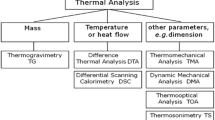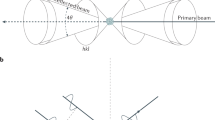Abstract
The established procedure for the estimation of purity from differential calorimetric melting range results involves empirical linearization of the data, which can be time consuming and may introduce a subjective element into the calculation. This is sometimes thought to be a disadvantage of the method. A modification of the procedure has been developed which avoids this difficulty and offers advantages in ease of data logging and of overall computer programming.
Résumé
Le procédé actuellement répandu pour estimer la pureté par analyse calorimétrique différentielle à partir de l'intervalle de fusion fait appel à la linéarisation empirique des données. Cette opération peut être longue et elle est susceptible d'introduire des éléments subjectifs dans le calcul. Ceci est parfois considéré comme un inconvénient de la méthode. Une modification de ce procédé est proposée dans le présent article pour éviter cette difficulté. Son avantage réside dans la facilité de conserver les données et d'effectuer la programmation générale sur ordinateur.
Zusammenfassung
Das für die Reinheitsbestimmung aus Ergebnissen differentialkalorimetrisch ermittelter Schmelzbereiche festgelegte Verfahren benötigt die empirische Linearisierung der Angaben, was zeitaufwändig sein kann und subjektive Elemente in die Berechnungen einführt. Manchmal wird dies als ein Nachteil der Methode betrachtet. Eine Modifizierung des Verfahrens wurde erarbeitet, welches diese Schwierigkeit beseitigt und bei Datenspeicherung und allgemeiner Computerprogrammierung vorteilhaft ist.
Резюме
Принятый метод опред еления чистоты, исход я из результатов диффере нциальной калориметрической о бласти плавления, вкл ючает эмпирическую линейн ость данных, что требует времени и может ввести субъект ивный элемент при вычислен ии. Считается, что это является недоста тком метода. В связи с э тим разработан модифици рованный метод, который исключает эт и трудности и дает пре имущества в облегчении нивелиро вания данных и полного программир ования на ЭВМ.
Similar content being viewed by others
References
Thermal Analysis Newsletters, No. 5 and No. 6, Analytical Division, Perkin-Elmer Corporation, Norwark, Conn. U.S.A.
C. Plato andA. R. Glasgow, Anal. Chem., 41 (1969) 330.
P. Sanmartin andN. Regine, J. Thermal Anal., 1 (1969) 403.
R. A. W. Hill andB. W. Rodger, Proc. Soc. Anal. Chem., 8 (1971) 165.
G. J. Davis andR. S. Porter, J. Thermal Anal., 1 (1969) 449.
B. W.Rodger, private communication.
K. A.Fraser, private communication.
Author information
Authors and Affiliations
Additional information
The authors thank staff of the Computer Department, Glasgow College of Technology for invaluable assistance in compiling this programme.
Rights and permissions
About this article
Cite this article
Cooksey, B.G., Hill, R.A.W. Purity measurement by differential scanning calorimetry: An alternative method of computation. Journal of Thermal Analysis 10, 83–88 (1976). https://doi.org/10.1007/BF02179193
Received:
Issue Date:
DOI: https://doi.org/10.1007/BF02179193




